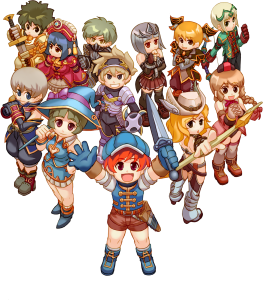Basic AoE Ringmaster Guide
Table of Contents
Introduction
This guide is for those of you who want to play a Facetank AoE Ringmaster. First, a brief note: the Ringmaster is actually one of the more complex AoE characters because there are different ways to play them. There is one crucial element we’ll discuss in detail shortly.
This guide is primarily aimed at free-to-play players, meaning we’re assuming you don’t have access to top-tier gear, consumables, or high-level support. Additionally, you might not have the highest possible upgrades. However, one thing you should aim for is a basic level of preparation; otherwise, the experience will be significantly more challenging.
It is definitely possible to play a completely solo, independent AoE Ringmaster as a facetank AoE character—one who relies mainly on Merkaba Hanzelrusha for damage. While you can succeed solo, this setup works even better when supported by a partner or when dual-AoE playing with another character. The reason is simple: the skills stack well together, including double Heal Rain and double damage with Merkaba. One player can act as the tank and pull mobs, while the other supports and deals additional damage. This synergy makes the duo nearly unstoppable.
Having an additional healer is extremely powerful and can make you almost invincible. It’s something you want if possible, but if you don’t have it, solo play still works effectively.
Stat Points and Build
When it comes to the stat points for an AoE Ringmaster, there are several viable approaches, ranging from full INT to incorporating some STA. Your stat distribution will depend on your personal situation.
If this is your first character or if you’re playing without additional resources, this will influence your choices. For example, if you have access to consumables or better gear, your approach may differ. But in this guide, we are assuming minimal equipment.
For free-to-play players, We recommend investing 50 STA by Level 60. This is a safe and solid choice. In some cases, you could even go up to 80 STA, but we wouldn’t advise going higher than that. In fact, keeping it closer to 50 STA (or even less) is ideal because INT is critical for your damage output.
The less INT you have, the less damage you’ll deal, and this is crucial since you primarily rely on Merkaba Hanzelrusha for AoE damage. If your Merkaba doesn’t deal sufficient damage, your overall strategy won’t work as effectively. Therefore, focusing on INT is key to maximizing your damage.
Moreover, INT not only boosts your damage but also improves your buff boost (every +25 INT), making you more tanky through stronger self-buffs. This dual benefit of INT enhances your survivability and damage potential, making it a highly advantageous stat for an AoE Ringmaster.
Skill Points "K" & Buffs
Key Buffs and Skills for the Ringmaster
Now, let’s talk about the buffs and skills for the Ringmaster. This will be a thorough breakdown, as each skill has its own unique importance.
At Level 60, your first priority is to max out Merkaba Hanzelrusha. This is your primary AoE damage skill, and it’s essential for your effectiveness in battle. Without it, your AoE strategy simply won’t work.
Next, you’ll want to max out Prevention and Stonehand. These are your core abilities:
- Stonehand: Ensures that monsters are stunned by Merkaba, giving you the crowd control needed to handle multiple enemies.
- Prevention: Acts as a safeguard against death by healing you to full HP when you drop below 15%. Once activated, it has an 8-second cooldown, after which you can reactivate it. This makes the healing process passive and automatic, reducing the need for manual healing in early game battles. As monsters get stronger later on, you may need to incorporate more manual healing, but in the beginning, Prevention simplifies survival.
Managing Healing and Buffs
When it comes to healing, my personal recommendation is to keep the Heal skill at a low level, ideally around Level 3. In the early game, especially with Prevention and Stonehand, along with decent armor, you should take minimal damage, reducing the need for frequent healing.
For buffs, prioritize defensive and utility buffs such as:
- Patience: Boosts your HP.
- Heap Up: Provides additional STA for better tanking.
- Cats Reflex: Increases your block rate, crucial for mitigating damage.
These buffs will significantly improve your defense, making you more resilient against mobs. INT buffs, such as Mental Sign, are also important as they enhance your overall healing power, buff effectiveness, and damage output from Merkaba.
Attack Speed and Other Buffs
While attack speed buffs like Haste are useful, they are less of a priority compared to your defensive buffs. However, don’t completely neglect Haste, as faster attacks allow you to reactivate Prevention sooner and deal more consistent damage.
Other buffs like Cannon Ball, Beef Up, and Accuracy are not essential for the Ringmaster’s AoE playstyle. Cannon Ball, in particular, offers some utility but isn’t crucial. Save these for later when you have spare skill points.
Additional Buffs
As for other notable Ringmaster skills:
- Protect: Boosts your defense by 10%, adding to your tankiness. Max this as soon as possible to improve your overall durability.
- Spirit Fortune (SF): Available at Level 65, this skill increases your damage and is worth investing in if you have extra skill points. At a minimum, keep it at Level 1.
Niche Skills
- Holyguard: Reduces your susceptibility to critical hits, giving you more resilience against high-damage strikes. Use this skill when you’ve gathered mobs and are ready to start your AoE cycle. Pair it with Merkaba and Stonehand to minimize incoming damage. If you find that it’s not making much difference, feel free to skip it, but it’s worth testing.
- Geburah Tiphreth (GT): Is extremely valuable as it increases both your casting time and attack,
- Barrier of Life: Available at Level 100, this ultimate defense skill provides superior protection for a very short time. It’s more of a “panic button” than a long-term solution, offering a brief 2-second window of invulnerability. Use it in critical moments, such as when you’re overwhelmed by too many mobs, or if your buffs have expired unexpectedly. While it’s not something to rely on regularly, it can save you in tight spots.
- Burst Crack (Assist skill): This skill is more relevant for a dual-player setup. However, if you’re playing free-to-play and solo, it’s not as necessary.
Cloak
Regarding your cloak, you have the choice between +8 INT (Cloak of Wisdom) or +8 STA (Cloak of Endurance) bonuses, depending on your build. If your build is more INT-focused, go with a STA cloak for extra defense. Otherwise, opt for an INT cloak if you feel secure in your ability to tank but need more damage.
Pet
When it comes to pets, an HP pet is highly recommended. Avoid a Fox, as it requires significant investment before its INT bonus makes a noticeable impact. An HP pet provides a consistent and affordable increase to your HP, making it easier to tank larger groups of mobs. This extra health buffer can significantly improve your ability to survive in battle, especially when taking on more challenging mobs.
Jewelry
When it comes to jewelry, INT rings called Intiret+1 are non-negotiable. You definitely want to equip them as they are essential for maximizing your character’s effectiveness.
For earrings, We recommend starting with Penzeru +1 in the early game. My personal opinion on Speedos +1 is not very positive, as they offer only a small increase in block rate. In contrast, the benefits of Penzeru +1 far outweigh those of Speedos +1, especially in the early game when defense mitigation is critical.
At Level 60, the difference between wearing two Penzeru +1 is substantial; monsters seem to deal 30% less damage per hit. This reduction in damage is much more noticeable than the small block rate provided by Speedos +1. However, if you can acquire Speedos +2 or +3, the situation changes dramatically, especially at higher levels. At that point, Speedos become a viable option, though they are quite expensive. Until then, stick with Penzeru +1, which will serve you well.
For necklaces, we suggest going with an HP necklace to further boost your survivability.
Element, Skill Damage, and Sockets
The element of your weapon is irrelevant for the Ringmaster AoE build. Instead, your sockets should focus on INT rather than STA or skill damage. INT provides dual benefits: it increases both your buffs and damage output. STA, on the other hand, offers relatively lower returns compared to INT. Therefore, we recommend socketing INT for a more efficient build.
Socketing and upgrading your gear is generally something you’ll focus on in the higher levels. Early on, it doesn’t make a huge difference since the lower-level cards are quite weak. Save your resources for later upgrades, where they’ll have a much more noticeable impact.
Skill Damage
Your goal should be to maximize Merkaba Hanzelrusha damage (with Scroll of Weapon Bonus), as it is your primary and nearly only significant damage-dealing skill. Focus on increasing its damage output as much as possible.
Set Upgrades and Sockets
Regarding set upgrades, the rule of thumb is similar to most other classes. Aim for a minimum of +5, with +6 being very achievable using Low Scroll of SProtect. If you have the opportunity, consider buying a pre-upgraded set, potentially with some sockets.
For sockets, in the early game, 3 sockets with HP rate is the best choice. In theory, you could consider attack later when you feel secure enough in your defense that you no longer fear dying. However, this is rare, and HP rate is the go-to option for most Ringmasters. Revenio/Revenis Set at higher levels might benefit from an attack power socket, but for the early and mid-game, stick with HP.
A +5 or +6 set should be sufficient until Level 105. At that point, +8 becomes a solid investment for your facetank build, as it significantly increases your HP and block rate. If you have the budget, upgrading to +8 or even +10 will make a noticeable difference in your durability and overall survivability.
Higher-Level Sockets and Set Upgrades
From Level 105 onwards, aim for at least a +8 set to take full advantage of the increased HP and block rate. Additionally, make sure your set has all four sockets, ideally with a minimum of 4% HP in each socket. At this stage, the more you invest in your set, the better your performance as a facetank Ringmaster will be.
Remember, while higher upgrades and sockets can be costly, they are well worth the investment as they drastically improve your tanking capabilities, especially in higher-level content.
Sets Overview
When selecting sets for your Ringmaster, here’s what we recommend:
Level 50-53: CW Assist Set (Rashadain/Yuandain)
At the beginning, you should use the Clockworks Assist Set— Rashadain/Yuandain Set (level 50). Upgrade it to at least +5 with one or two HP Rate socket cards (Volcano Card), and you’ll be extremely tanky early on. Combined with Prevention and Stonehand, this setup makes you virtually invincible at the start.
This set is perfect up until Level 75, helping you through the early levels as you unlock critical skills like GT, Heal Rain, and others. It provides an excellent introduction to the AoE playstyle and will help you establish your own combat rhythm.
Level 75: Pact/Paxt Set
After reaching Level 75, it’s time to switch to the Pact/Paxt Set. This isn’t necessarily for the casting time, but for the skill damage +10% boost. As previously mentioned, skill damage is your primary source of AoE power, so squeezing out any additional damage is beneficial.
The Pact Set also provides HP Rate +15%, covering both damage output and survivability. The only thing it lacks is a bit of block rate, which would have made it the perfect set. However, despite this minor flaw, the set is excellent for transitioning into tougher content.
Comparing the Clockworks Assist Set and the Pact/Paxt Set, the former reduces the damage you take due to its high defense, while the latter enhances your own damage output but leaves you a bit more vulnerable. You can experiment and decide which suits your playstyle better based on your equipment and preferences. Personally, we favor the Pact/Paxt Set for its damage increase, as Prevention and Stonehand should provide enough defense to offset the higher damage you might receive.
Level 105: Navil/Neclus Set and Rimyth/Remingster Set
At Level 105, you have the option to switch to a high casting time set with a healing bonus. However, we don’t recommend this as the casting time isn’t a critical factor for the AoE playstyle. Instead, opt for the Rimyth/Remingster Set
This set is particularly useful in Darkon 3 Desert, the main leveling area from Level 105 onwards, where the monsters deal a tremendous amount of damage. The Rimyth/Remingster Set provides critical bonuses like block rate +10%, HP +15%, and critical resistance +10%, which are essential for facetanking at this level. It even offers some casting time +10%, though this remains a secondary concern.
Level 120: Revenio/Revenis Set
Once you reach Level 120, it’s time for the ultimate AoE set—the Revenio/Revenis Set. This set offers everything you need:
- +20% PvE Damage: Allows you to deal with higher-level monsters more effectively.
- +10% Block: You get way less damage.
- +15% PvE Damage Reduction: You get way less damage.
- +25% HP: You can tank more mobs.
- +10% Healing
This set is a must-have and is crucial for high-level AoE. It maximizes your survivability and damage, making it indispensable from Level 120 onwards.
Level 150: Reine/Rayne Set
At even higher levels, at level Level 150, you can further upgrade to the Reine/Rayne Set, which is essentially an enhanced version of the Revenio/Revenis Set. It boosts all stats by approximately 5%, and a new stats Critical Resistance +10%, making it the ultimate high-level set.
Ringmaster Weapons
Choosing the right sticks for your Ringmaster is crucial to balancing offense and defense throughout the game. Here’s a breakdown of the best sticks for each level-
Level 60: Guardian Stick
At Level 60, the Guardian Stick becomes essential. This stick is critical because it’s the first to offer the potential awakening increased Merkaba skill damage boost along with additional stats like 15% HP rate and +7 INT, which are exactly what you need at this stage.
While casting time isn’t a priority for your build, defensive stats are, and the Guardian Stick provides a solid foundation. You don’t need to worry about casting speed early on, as survival and boosting your skill damage are far more important.
The Historic Stick, by comparison, offers Casting time +15%, and 30% MP, which isn’t as valuable—especially since the MP bonus feels a bit random and less useful. So don’t use this one.
Level 90: Angel Stick
At Level 90, upgrade to the Angel Stick. This stick is essentially a better version of the Guardian Stick, offering 20% HP and +15 INT. Like before, your focus should be on boosting Merkaba skill damage.
The Legendary Golden Stick ensures that you’re even tankier while also dishing out more damage, making it an ideal upgrade for this level range.
Level 105: Mythical Silver Stick
Once you hit Level 105, the Mythical Silver Stick becomes available. This stick further enhances your survivability with 20% HP, +15 STA, and 10% block rate. It’s a defensive powerhouse that lets you face-tank more efficiently while still maintaining a respectable level of offense.
Level 120: Bloody Stick or Bloody Obsidian Stick
At Level 120, you’ll have a choice between two sticks: The Bloody Stick and the Bloody Obsidian Stick. Your choice depends largely on your playstyle and equipment.
- Bloody Stick: Attack+10%, Healing+10%, Casting Time+25%, and Steal HP +1%. This is the offensive option. It allows you to heal based on the damage you deal, increases your overall damage, and boosts your casting time. This stick is perfect for those who want to maximize damage output while still maintaining some self-healing capabilities. It’s the more aggressive choice.
- Bloody Obsidian Stick: HP+25%, STA+20, and Incoming Damage -8%. This stick, on the other hand, is all about defense. If you’re focused on tanking and surviving tough encounters, this is the safer option. With the Revenio/Revenis Set or another strong defensive set, this stick will make you nearly unkillable. If you’re unsure, this stick is generally the better choice for safer gameplay.
For those confident in their gear and with a solid support team (like a healer), the Bloody Stick may be more appealing. But for players who value defense above all else, the Bloody Obsidian Stick is the safer bet.
Level 150: Song of Sirens or Lusaka's Stick
In the high-level game, particularly from Level 150, you’ll encounter two more options: the Song of Sirens (Stick of Hernes) and Lusaka’s Stick.
- Song of Sirens : +10~15% Attack; +10~15% Healing; +26~30% Casting time, and 4~9% Skill Chance for Water Bomb. This is the ultimate offensive stick. It shares many similarities with the Bloody Stick but lacks the self-healing feature. Instead, it offers a chance to trigger Water Bomb, a skill based on your level that significantly boosts your damage. This stick is perfect for players focused on maximizing their AoE damage and overall offensive potential.
- Lusaka’s Stick: +25~30% Attack; +25~30 STA; -6~10% Incoming Damage, and 1~3% Skill Chance for Stun (1 for PvE and one for PvP). This is the ultimate defensive stick. It offers incredible defensive stats and even has a chance to trigger Stun (a second Stonehand), giving you additional crowd control and survivability. This stick makes you nearly invincible, ensuring that even in the toughest fights, you have a much higher chance of survival. It’s the perfect choice for those prioritizing defense and survivability.
However, both of these sticks are extremely rare and expensive, so they are typically only relevant for late-game players with the resources to invest in such powerful gear.
AoE Ringmaster playstyle Tips
In this section, we will guide you through the basics of Ringmaster playstyle, demonstrating how to efficiently play as an AoE Ringmaster and offering tips for both simple and more advanced tactics.
AoE Ringmaster playstyle
The core of Ringmaster gameplay is fairly straightforward. Here’s how you can begin:
- Pulling Monsters: Use your stick to pull monsters, casting Merkaba periodically to deal some early damage. Continue running around and gathering as many monsters as you feel comfortable tanking. The number of monsters you pull depends on your confidence in handling them and your knowledge of your capabilities.
- Stationary Combat: Once you’ve gathered enough monsters, stop and start casting Merkaba Don’t forget to heal yourself with Prevention (PR) and make sure GT and Stonehand are always active. Continuously spam Merkaba on cooldown to maximize your damage.
- Managing Buffs: Keep a close eye on your HP, buffs, and cooldowns. Always ensure that Prevention is ready to activate and rebuff whenever necessary. Your main focus should be to keep Merkaba running, maintain your buffs, and ensure that your HP doesn’t drop too low.
This method is the standard and most reliable way to play as an AoE Ringmaster. While it’s simple, it still requires practice to gauge how many monsters you can safely handle. The key is to stay mindful of your buffs and defensive abilities at all times. It’s also essential to know your limits—don’t over-pull if you’re unsure of your tanking abilities.
Advanced Tactics: Barrier of Life and Holyguard
To further enhance your gameplay, consider incorporating Barrier of Life and Holyguard into your routine. These skills offer additional protection and can be lifesavers in tough situations. Here’s a possible sequence:
- Start with Pulling: Begin by pulling monsters as usual.
- Activate Barrier of Life: Once you’re stationary, cast Barrier of Life for added protection. Follow it up with Merkaba or other skills.
- Use Holyguard: When Barrier of Life wears off, activate Holyguard to provide extra defense and mitigate damage.
- Maintain Buffs: Throughout this process, keep Merkaba running, ensure Prevention is active, and rebuff as needed.
This tactic adds layers of defense and reduces the risk of taking lethal damage, particularly useful in situations where you may feel overwhelmed.
Incorporating Second Supporter
One of the best ways to simplify the playstyle is to have a second Ringmaster or a dedicated healer in your party. This allows you to focus solely on damage output without needing to worry about healing yourself.
- Damage Focus: If you have a second supporter handling healing, your job becomes much easier. Simply focus on keeping Merkaba and your other buffs active, while ensuring you’re dishing out as much damage as possible.
This setup makes the playstyle more relaxed and allows for smoother pulls and overall better efficiency.
Complex Playstyle: Switching Between Weapons
For those looking for more of a challenge, you can deviate from the standard Ringmaster playstyle and go for a more complex, high-DPS method. Here’s how it works:
- Switching Between Stick and Knuckle: After casting Merkaba, switch to a Knuckle and Shield and start spamming Burst Crack. This adds an additional layer of AoE damage while Merkaba is on cooldown.
- Managing Cooldowns: After using Burst Crack, switch back to your stick, cast Merkaba and Prevention as needed, then switch back to Knuckle and Shield for more Burst Crack.
This playstyle is extremely demanding because it requires constant switching between weapons, monitoring buffs, and making sure your HP stays high. Additionally, you’ll need a strong support team—ideally, another Ringmaster—to handle healing while you focus on dealing damage.
- Downside: This method requires dual sets of high-end equipment (e.g., high-level knuckles and shields) and is generally more expensive to maintain. It’s also incredibly taxing in terms of reaction time and awareness, making it unsuitable for players who prefer a more relaxed playstyle.
Pros and Cons of Advanced Tactics
- Pros: This playstyle can push your DPS to its absolute limit, making you a much more formidable force in combat. It’s an excellent option if you’re bored with the standard AoE method and want a more engaging experience.
- Cons: The equipment requirements and complexity make it less practical for free-to-play players or those who lack the resources to maintain two sets of high-level gear. It’s also highly demanding and stressful due to the constant weapon switching and need for a second supporter.
Conclusion
In conclusion, Ringmaster gameplay can be as simple or complex as you choose. The basic AoE Ringmaster playstyle is easy to learn and effective once you establish a routine of pulling, casting Merkaba, healing with Prevention, and keeping buffs like GT and Stonehand active.
For those seeking a challenge, the advanced playstyle involving weapon switching between Stick and Knuckle introduces a higher level of complexity but requires a strong support system and dual sets of high-quality gear. However, this style is not recommended unless you’re comfortable with the standard play and have the resources to support it.
Ultimately, adding a second Ringmaster or healer to your party can make playstyle much more relaxed.
Source: The Guide was originally explained by Spielestyler in his YouTube video in German.










